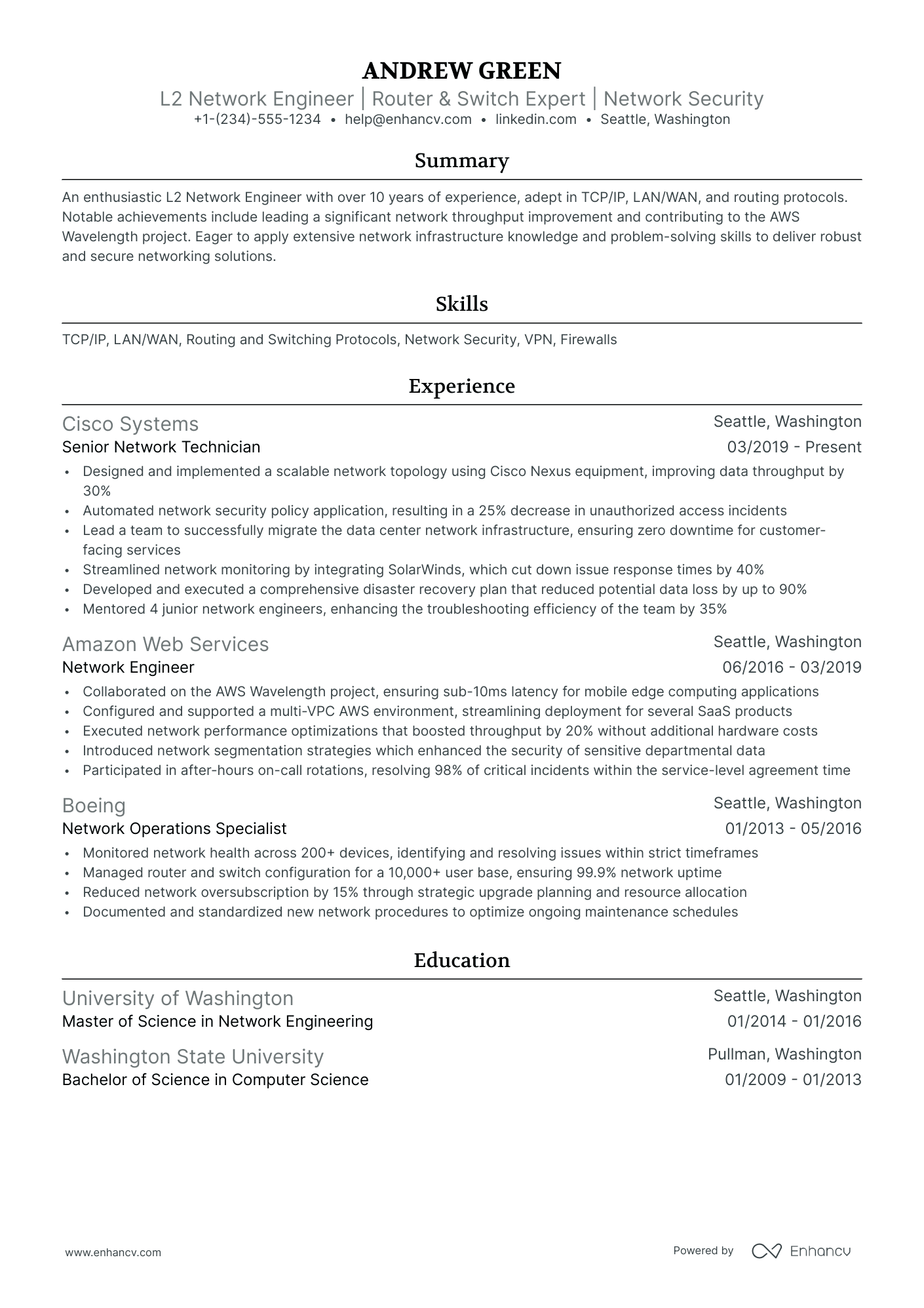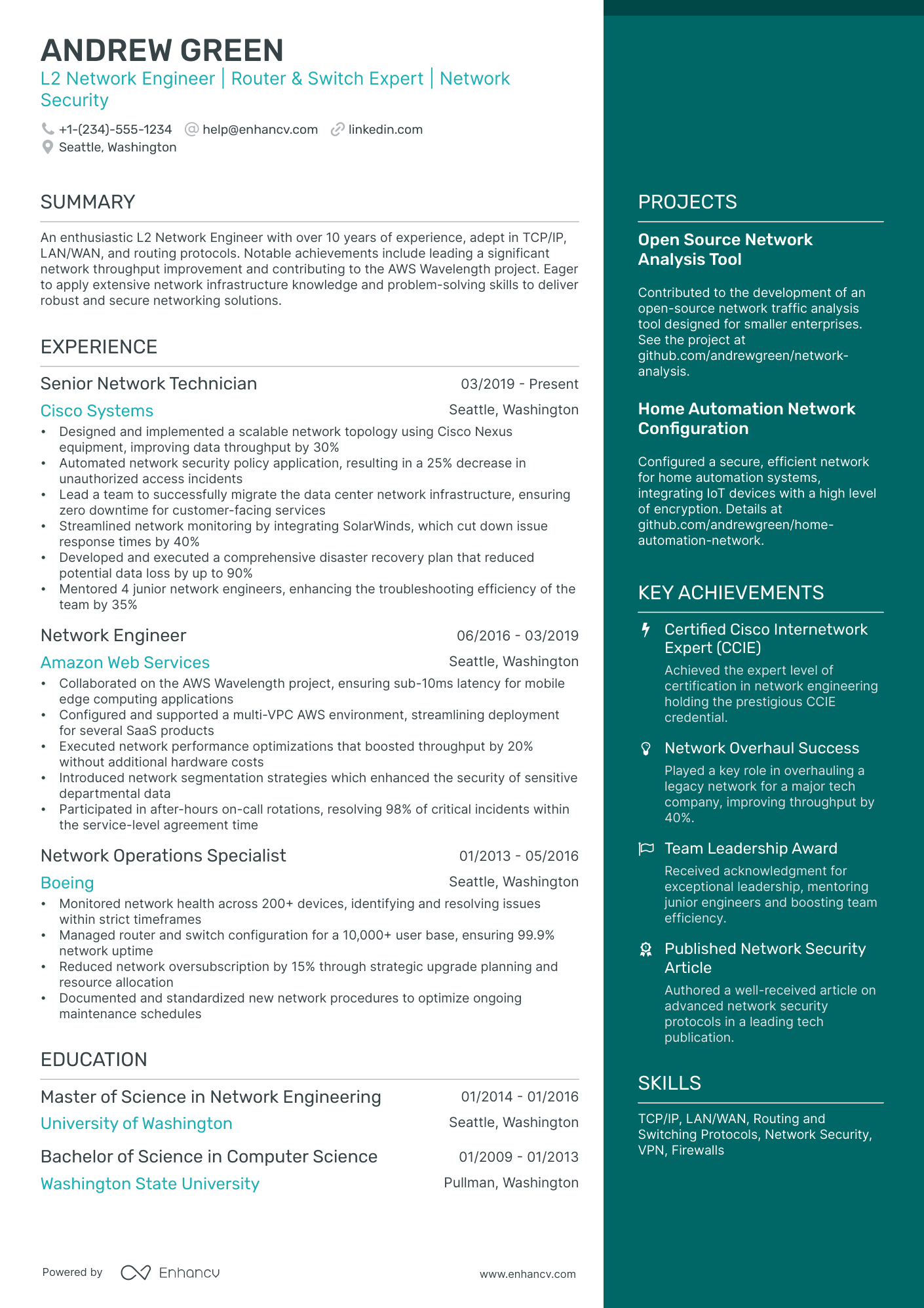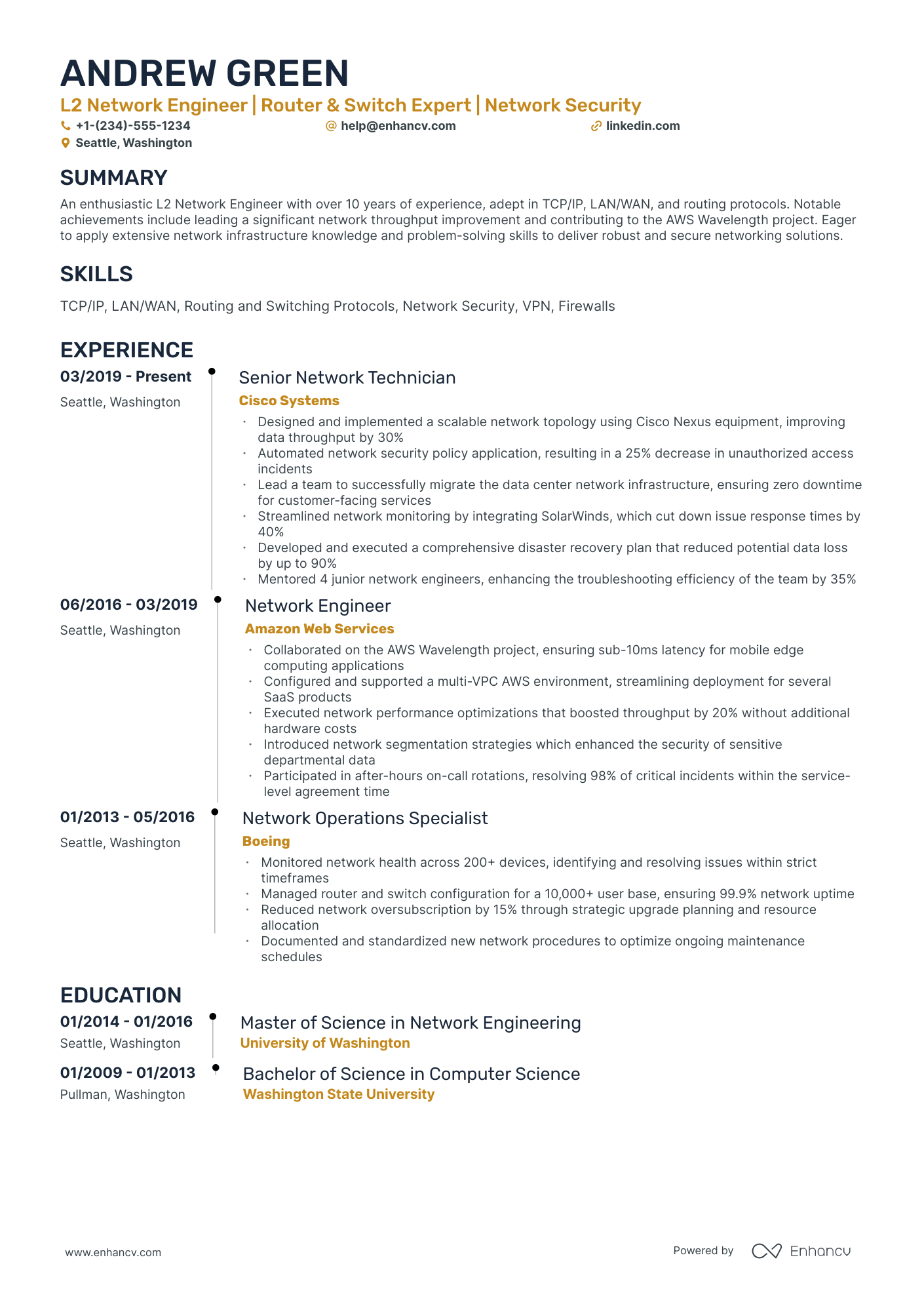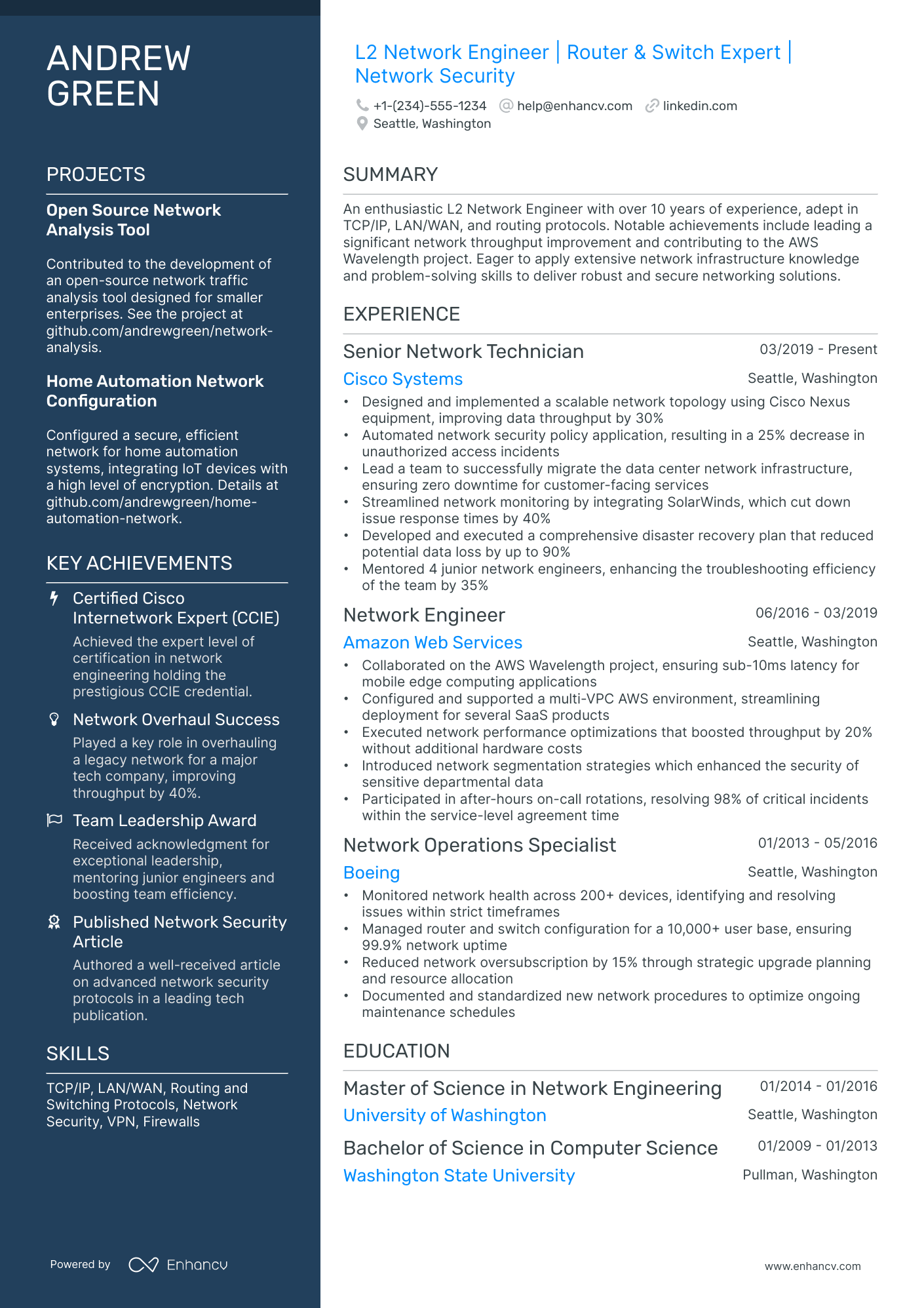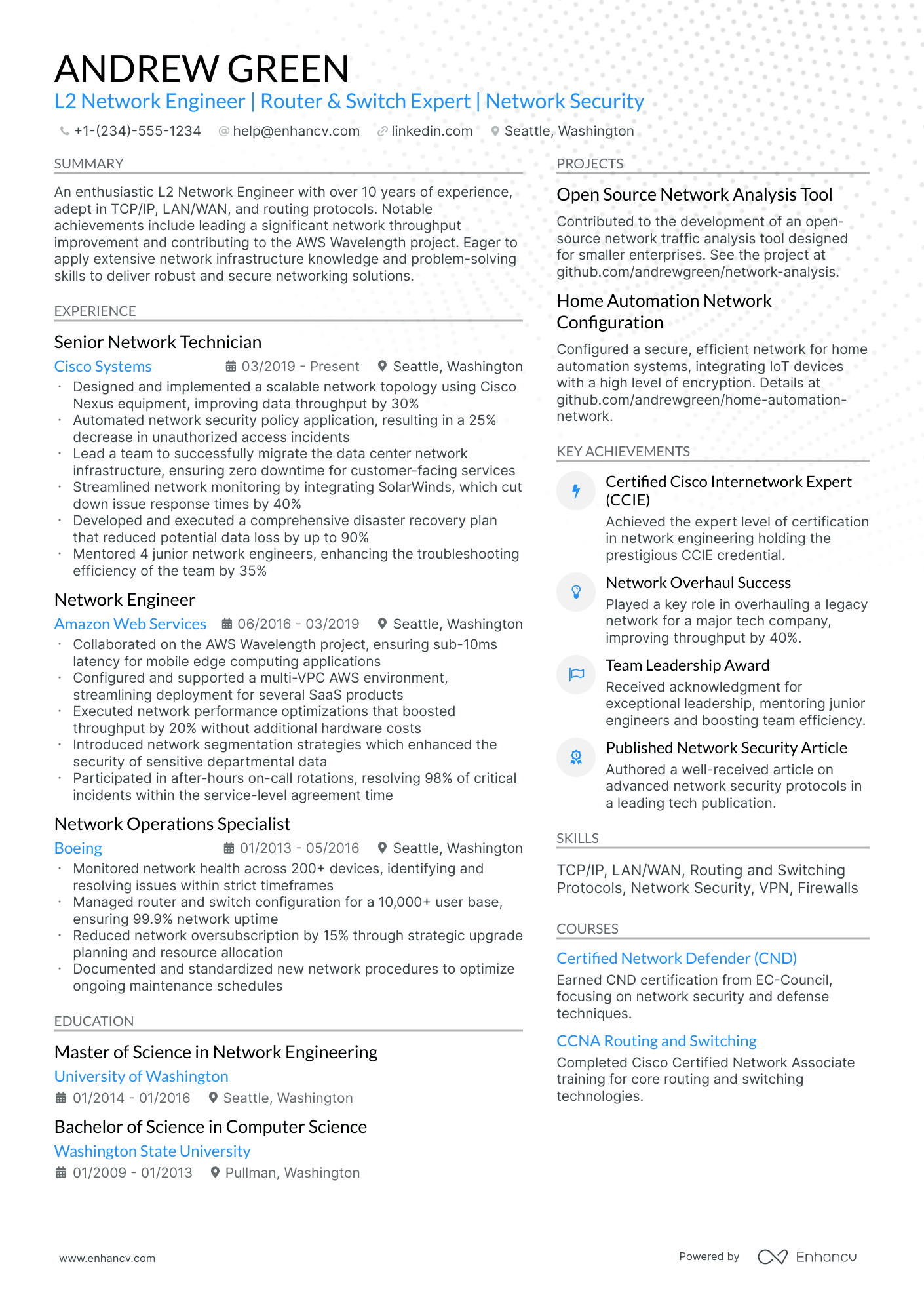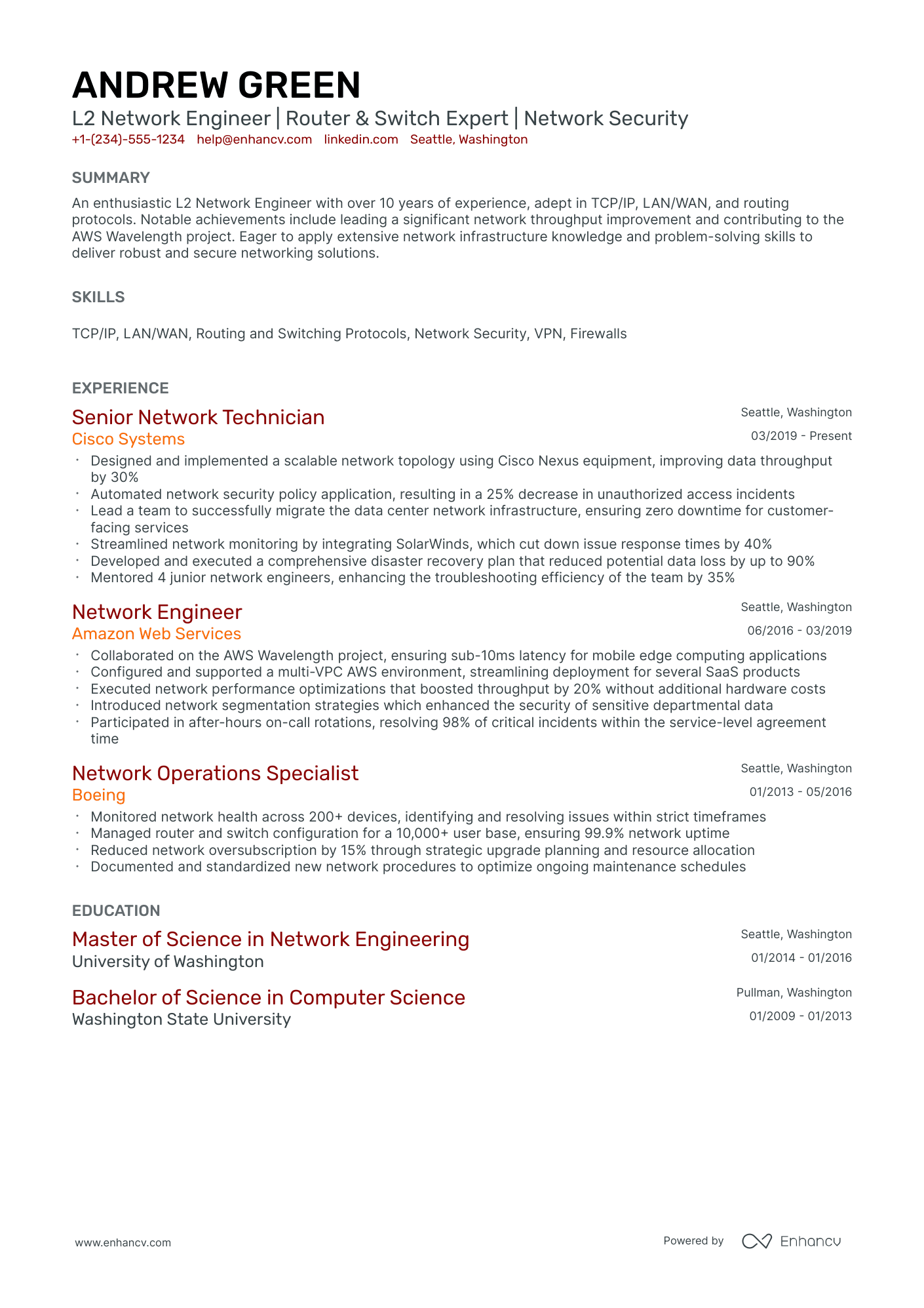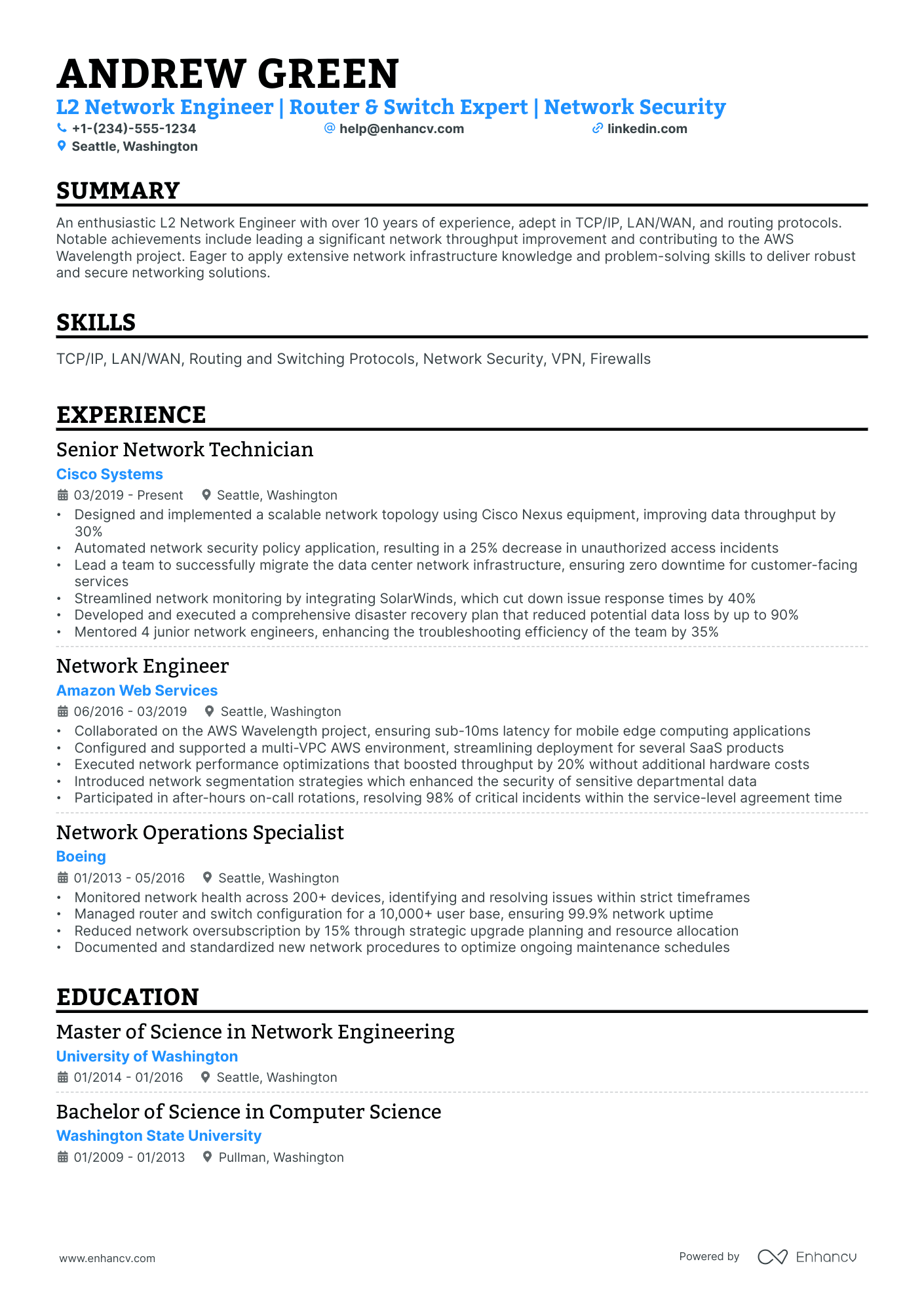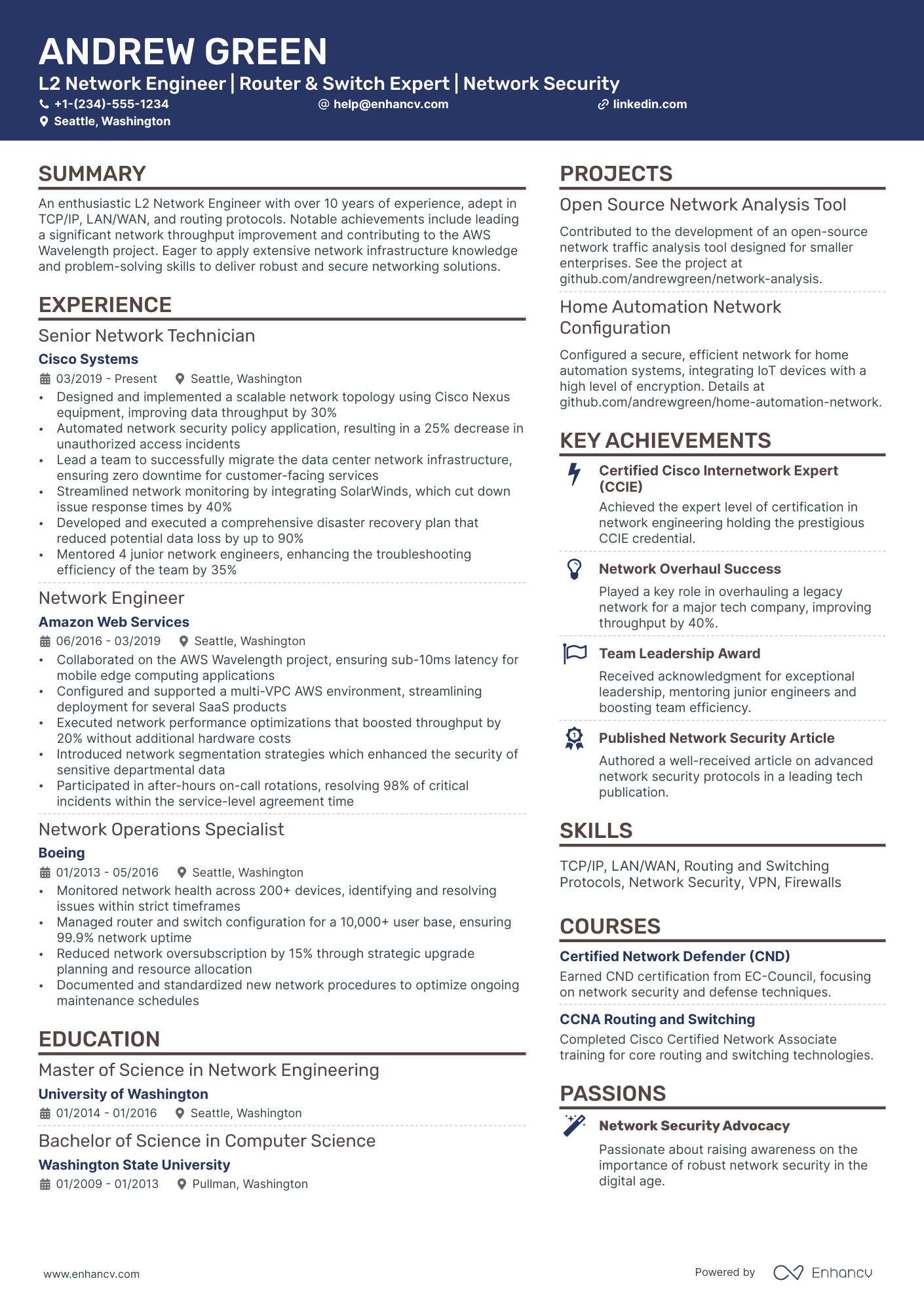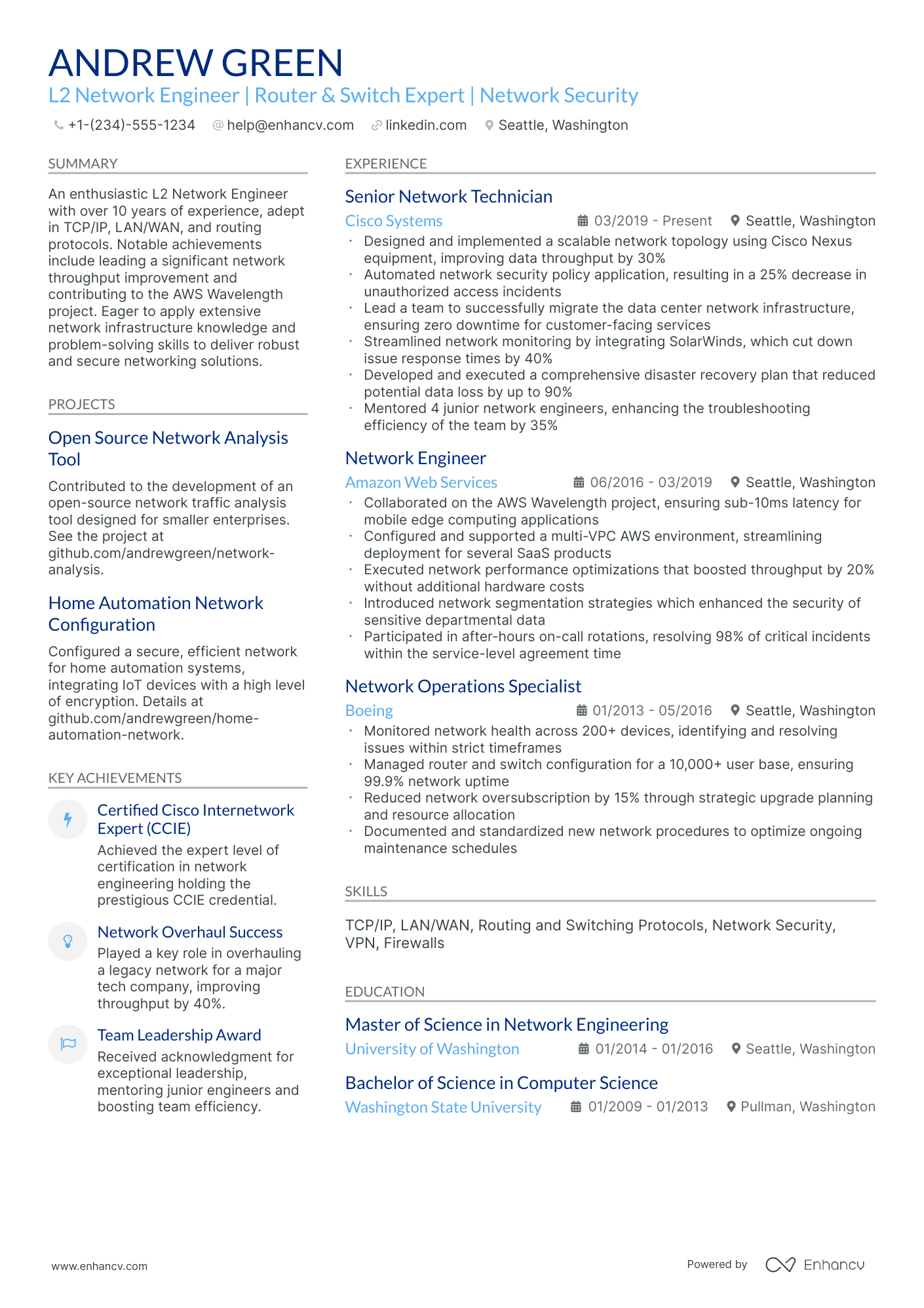As an L2 network engineer, articulating the complex technical projects you've managed on your resume can be challenging while ensuring non-technical managers can comprehend your expertise. Our guide provides tailored strategies to translate your technical accomplishments into clear, impactful bullets that resonate with all hiring managers, ensuring your resume stands out.
- L2 network engineer resume samples that got people hired at top companies.
- How to perfect the look-and-feel of your resume layout.
- How to showcase your achievements and skills through various resume sections.
- How you could hint to recruiters why your resume is the ideal profile for the job.
If the L2 network engineer resume isn't the right one for you, take a look at other related guides we have:
- IT Support Manager Resume Example
- QA Analyst Resume Example
- Computer Technician Resume Example
- Statistical Programmer Resume Example
- IT Infrastructure Project Manager Resume Example
- Python Full Stack Developer Resume Example
- System Analyst Resume Example
- Computer Engineer Resume Example
- Cmm Programmer Resume Example
- IT Technician Resume Example
Designing your L2 network engineer resume format to catch recruiters' eyes
Your L2 network engineer resume will be assessed on a couple of criteria, one of which is the actual presentation.
Is your resume legible and organized? Does it follow a smooth flow?
Or have you presented recruiters with a chaotic document that includes everything you've ever done in your career?
Unless specified otherwise, there are four best practices to help maintain your resume format consistency.
- The top one third of your L2 network engineer resume should definitely include a header, so that recruiters can easily contact you and scan your professional portfolio (or LinkedIn profile).
- Within the experience section, list your most recent (and relevant) role first, followed up with the rest of your career history in a reverse-chronological resume format .
- Always submit your resume as a PDF file to sustain its layout. There are some rare exceptions where companies may ask you to forward your resume in Word or another format.
- If you are applying for a more senior role and have over a decade of applicable work experience (that will impress recruiters), then your L2 network engineer resume can be two pages long. Otherwise, your resume shouldn't be longer than a single page.
Upload & Check Your Resume
Drop your resume here or choose a file. PDF & DOCX only. Max 2MB file size.
PRO TIP
List all your relevant higher education degrees within your resume in reverse chronological order (starting with the latest). There are cases when your PhD in a particular field could help you stand apart from other candidates.
Traditional sections, appreciated by recruiters, for your L2 network engineer resume:
- Clear and concise header with relevant links and contact details
- Summary or objective with precise snapshot of our career highlights and why you're a suitable candidate for the L2 network engineer role
- Experience that goes into the nuts and bolts of your professional qualifications and success
- Skills section(-s) for more in-depth talent-alignment between job keywords and your own profile
- Education and certifications sections to further show your commitment for growth in the specific niche
What recruiters want to see on your resume:
- Proficiency in configuring, managing, and troubleshooting VLANs, STP (Spanning Tree Protocol), and trunking technologies like 802.1Q.
- Hands-on experience with layer 2 network hardware such as switches, hubs, and bridges, including vendors like Cisco, Juniper, or Arista.
- Solid understanding of networking protocols relevant to layer 2 such as ARP, LLDP, and EtherChannel / Port Aggregation.
- Experience with network security practices, including setting up ACLs (Access Control Lists), port security, and understanding of 802.1X / NAC (Network Access Control).
- Ability to use network monitoring and analysis tools (such as Wireshark, SolarWinds, PRTG) for troubleshooting and optimizing network performance.
Essential tips for crafting your L2 network engineer resume experience section
The experience section is indeed the core of your L2 network engineer resume. It's where you present your past and current job roles. But how should you approach this crucial part?
A common error is treating the experience section as merely a list of job duties. Many candidates fall into the trap of detailing what they did without illustrating the impact of their actions.
To effectively write your L2 network engineer resume experience section, consider these guidelines:
- Emphasize your achievements, supported by concrete metrics such as percentages, revenue increases, or customer satisfaction rates;
- Avoid using generic buzzwords like communication, hard work, or leadership. Instead, demonstrate how these skills added value in your previous roles;
- Begin each bullet point with a strong action verb, followed by a skill, and then the result of your actions;
- Tailor your resume for each job application by selecting the most relevant experiences, responsibilities, and successes.
We have an array of resume examples that illustrate how to optimally curate your L2 network engineer resume experience section.
- Led the deployment of a new VLAN architecture for the enterprise network across 20 locations, enhancing network security and performance.
- Collaborated with cross-functional teams to troubleshoot and resolve complex network outages, reducing downtime by 30%.
- Optimized network configurations, which increased data throughput by 25% for critical business applications supporting remote workforce.
- Designed and implemented a company-wide switch refresh project, upgrading 100+ devices, which resulted in improved performance and reliability.
- Managed firewall and security configurations for a network servicing over 10,000 users, ensuring robust security protocols were maintained.
- Initiated a network monitoring solution integration that reduced incident detection time by 40%, improving the response rate to network issues.
- Developed and executed a successful plan for the migration of data center networks to a virtualized environment, which increased resource utilization by 35%.
- Automated routine network maintenance tasks using custom scripting, saving the team approximately 10 hours per week.
- Served as the primary contact for ISP coordination and managed the WAN link upgrades that boosted the company’s internet bandwidth by 50%.
- Implemented Quality of Service (QoS) policies across the corporate network for prioritizing voice and video traffic, enhancing the quality of VoIP calls.
- Spearheaded a network segmentation project that significantly improved network security and management for client data processing.
- Handled the successful roll-out of a secure VPN solution for 500+ remote employees, enabling secure and flexible work environments.
- Managed network capacity planning and performed hardware upgrades that increased the data center’s capacity by 40%, meeting the growing demand for services.
- Contributed to reducing operational costs by 20% through the optimization of network device energy consumption.
- Provided significant enhancements to the disaster recovery plan by integrating a new backup network topology that improved recovery time objectives.
- Coordinated with vendors to ensure the successful deployment of network security appliances, directly bolstering network defenses.
- Participated in the adoption of SDN technologies that led to a more agile and programmable network infrastructure.
- Orchestrated a Wi-Fi network upgrade for a large campus area, enhancing connectivity for thousands of users including staff and visitors.
- Managed an inter-office LAN/MAN connectivity project covering three city locations, ensuring seamless network integration and data synchronization.
- Delivered comprehensive network documentation and training that helped increase the IT team’s efficiency in managing network resources.
- Successfully configured and supported a multi-vendor network environment, ensuring interoperability between Cisco, Juniper, and Huawei devices.
- Achieved a 99.9% network uptime by proactively addressing potential issues through continuous network performance monitoring and upgrades.
- Led an initiative to consolidate network data reporting which provided leadership with more accurate insights for decision making.
- Facilitated a series of network security audits that led to the implementation of enhanced encryption standards across corporate data transmissions.
Quantifying impact on your resume
- Incorporate the exact number of network devices you've managed or configured, demonstrating the scale of your responsibilities.
- Highlight the percentage reduction in network downtime achieved from your optimization efforts, showing your impact on reliability.
- Mention the number of network security incidents you've resolved, showcasing your skills in maintaining security protocols.
- Specify the volume of data traffic you've monitored daily or monthly, providing insight into your experience with large-scale networks.
- Detail the number of users supported by the networks you've managed, reflecting your ability to maintain performance in user-heavy environments.
- List the size of the teams you've collaborated with or led, indicating your teamwork and leadership abilities.
- Quantify the reduction in operational costs due to network improvements you've implemented, showing your contribution to financial efficiency.
- Present the number of successful network upgrades or migrations you've completed, establishing your effectiveness in project implementation.
Action verbs for your L2 network engineer resume
Lacking relevant L2 network engineer resume experience?
Learn how to write your L2 network engineer resume experience in spite of having no real-world (or applicable) experience for the job.
You should:
- Feature relevant projects or publications that could impress recruiters or showcase that you have the basic skill set for the job
- Shift the focus towards your people (communication, organization, etc.) skills to demonstrate that you're a quick learner and can easily adapt to a new environment
- Use the resume objective to not only highlight your accomplishments but also map out how your career plans are perfectly aligned with the company's vision
- Select either the functional-skill-based resume format (that puts the focus on your skills) or the hybrid one (balancing expertise with skills).
Recommended reads:
PRO TIP
Highlight any significant extracurricular activities that demonstrate valuable skills or leadership.
How to showcase hard skills and soft skills on your resume
Reading between the lines of your dream job, you find recruiters are looking for candidates who have specific software or hardware knowledge, and personal skills.
Any technology you're adept at shows your hard skills. This particular skill set answers initial job requirements, hinting at how much time your potential employers would have to invest in training you. Showcase you have the relevant technical background in your communicate, solve problems, and adapt to new environments. Basically, your interpersonal communication skills that show recruiters if you'd fit into the team and company culture. You could use the achievements section to tie in your greatest wins with relevant soft skills.
It's also a good idea to add some of your hard and soft skills across different resume sections (e.g. summary/objective, experience, etc.) to match the job requirements and pass the initial screening process. Remember to always check your skill spelling and ensure that you've copy-pasted the name of the desired skills from the job advert as is.
Top skills for your L2 network engineer resume:
Cisco Routing and Switching
Network Security
TCP/IP Protocols
VPN Configuration
Firewall Management
Network Monitoring Tools (e.g., Wireshark, SolarWinds)
Load Balancers
DNS and DHCP Management
BGP and OSPF Protocols
VoIP Technologies
Problem Solving
Communication
Team Collaboration
Time Management
Adaptability
Attention to Detail
Customer Service Orientation
Analytical Thinking
Critical Thinking
Project Management
PRO TIP
If you're in the process of obtaining your certificate or degree, list the expected date you're supposed to graduate or be certified.
The L2 network engineer resume sections you may underestimate: certifications and education
Your education and certifications provide insight into both your technical capabilities and personal attributes, such as perseverance. When crafting your L2 network engineer resume, consider how you present these elements:
- For your higher education degrees, prioritize listing those most relevant to the job or indicative of your academic dedication;
- Include applicable coursework as a stand-in for relevant experience or if it might impress recruiters;
- Include incomplete higher education only if it's pertinent to meeting job requirements;
- If your degree is from a renowned university, mention how often you made the Dean's list to underline academic excellence.
Regarding certifications, it's not necessary to list all of them. Instead, match up to three of your most recent or significant certificates with the technical skills required in the job description.
Below, we've selected some of the top industry certifications that could be vital additions to your L2 network engineer resume.
The top 5 certifications for your L2 network engineer resume:
- Certified Network Associate (CCNA) - Cisco
- Network+ (Network Plus) - CompTIA
- Certified Network Professional (CCNP) - Cisco
- Juniper Networks Certified Associate Junos (JNCIA-Junos) - Juniper Networks
- Certified Advanced Networking Specialist (CANS) - Global Information Assurance Certification (GIAC)
PRO TIP
Mention specific courses or projects that are pertinent to the job you're applying for.
Recommended reads:
Deciding between a resume summary or objective for your L2 network engineer role
Understanding the distinction between a resume summary and an objective is crucial for your L2 network engineer resume.
A resume summary, typically three to five sentences long, offers a concise overview of your career. This is the place to showcase your most pertinent experience, key accomplishments, and skills. It's particularly well-suited for those with professional experience relevant to the job requirements.
In contrast, a resume objective focuses on how you can add value to potential employers. It addresses why they should hire you and outlines your career expectations and learning goals. Therefore, it's ideal for candidates with less experience.
In the following section of our guide, explore how resume summaries and objectives differ through some exemplary industry-specific examples.
Resume summaries for a L2 network engineer job
- Achieved CCNA and CCNP certified professional with a robust 5-year tenure specializing in network infrastructure, elicits a strong command in designing, implementing, and troubleshooting complex L2 architectures. Streamlined company operations by delivering a 30% reduction in network downtime at TechSolutions, showcasing a proven track record in enhancing network performance and security.
- Eager to apply my 7-year expertise in IT support and recent transition into network engineering, where I have effectively completed a year of intense on-the-job training in L2 networking, optimizing data flow for small to mid-sized business networks. Commended for the swift resolution of network issues and adept in monitoring tools like SolarWinds and Wireshark.
- Bringing forth a year of dedicated experience in software development alongside a fresh Cisco certification, I have reshaped my directional focus towards network engineering to fortify multi-tiered network designs & maintenance. Recognized for authoring a popular open-source networking tool adopted by local tech communities, demonstrating a unique blend of programming and networking insight.
- Transitioning from a successful 4-year cybersecurity career, I am keen to leverage my expertise in network security protocols and intrusion detection to forge a new path in network engineering. My analytical abilities, honed through rigorous threat assessments, will enrich L2 network designs with top-tier security measures.
- Aspiring to join the dynamic field of network engineering, my objective is to apply my Bachelor's in Information Technology and accrued internship experience in network configuration to strengthen and support essential L2 network operations. Highly motivated to embrace hands-on learning opportunities and contribute to proactive network solutions.
- Seeking an entry-level opportunity to dive into the intricacies of L2 network engineering with a focused and structured progression plan. Armed with a recent diploma in Network Systems and internship experience at a local ISP, my goal is to advance technical proficiencies while driving the successful execution of networking projects.
Extra sections to include in your L2 network engineer resume
What should you do if you happen to have some space left on your resume, and want to highlight other aspects of your profile that you deem are relevant to the role? Add to your L2 network engineer resume some of these personal and professional sections:
- Passions/Interests - to detail how you spend both your personal and professional time, invested in various hobbies;
- Awards - to present those niche accolades that make your experience unique;
- Publications - an excellent choice for professionals, who have just graduated from university or are used to a more academic setting;
- Volunteering - your footprint within your local (or national/international) community.
Key takeaways
We've reached the end of our L2 network engineer resume guide and hope this information has been useful. As a summary of our key points:
- Always assess the job advert for relevant requirements and integrate those buzzwords across various sections of your L2 network engineer resume by presenting tangible metrics of success;
- Quantify your hard skills in your certificates and skills section, while your soft skills in your resume achievements section;
- Ensure you've added additional relevant experience items, such as extracurricular activities and projects you've participated in or led;
- Use both your resume experience and summary to focus on what matters the most to the role: including your technical, character, and cultural fit for the company.
